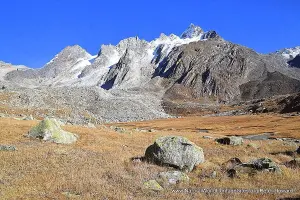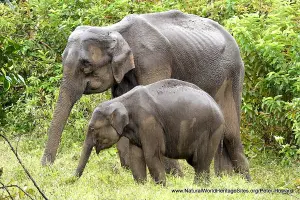EXPLORE THE KEOLADEO NATIONAL PARK with this slideshow, check the location map and get all the facts and information below.
For slideshow description see right or scroll down (mobile). Click to view slideshow
Location and Values: Keoladeo National Park is a green wetland oasis in India’s dry Rajasthan province, about 200 km south of Delhi. It serves as an important overwintering ground for large numbers of Palaearctic migratory waterfowl (ducks, geese, coots, pelicans, and waders) while also supporting a substantial population of resident breeding birds, with one of the region’s largest heronries. Although it is included on the world heritage list under natural criteria its existence as a permanent wetland is entirely artificial. It was originally developed as a duck-hunting reserve for the Maharajas at the end of the 19th century with the construction of an elaborate system of dykes and sluices to channel water into a natural depression. Subsequently it became a national park in 1982 and was amongst the first Indian sites to be inscribed on the world heritage list under natural criteria. Some 375 bird species have been recorded including 13 recognised as internationally threatened.
Conservation Status and Threats. According to IUCN’s most recent Conservation Outlook Assessment (December 2020) the conservation status of Keoladeo National Park is considered to be ‘good, with some concerns’. The exceptional values which are recognized by the site’s inscription on the World Heritage List are not seriously threatened, but a number of issues affecting conservation of the site are noteworthy, including:
- Insufficient replenishment of water to maintain wetland habitats. The wetland habitats at Keoladeo National Park are artificially maintained with seasonal inflows of water from sources outside the park. With the expansion of irrigated agriculture and urban demands elsewhere, water availability has become increasingly difficult and the park has often been unable to secure the minimum annual water flow (of 550 mcft) required to sustain the basic ecological functioning of the site. To help satisfy the site’s requirements there is a proposal to divert water from sewage treatment plants, but this will require strict water quality monitoring mechanisms that are not yet in place.
- Inadequate ecological monitoring programmes. Although there have been periodic counts of waterbirds, these have not been done in a systematic, consistent and replicable way, making it impossible to assess population trends over time. This is a significant constraint to management of the site which needs to be addressed
- Invasive alien species. Several invasive alien species of plants and animals are threatening the delicate ecological balance of the wetlands at Keoladeo National Park. Three of the most significant are the small mesquite tree (Prosopis juliflora), the floating aquatic water hyacinth (Eichhornia crassipes) and the predatory African cat fish (Clarias gariepinus). Control of these invasive species is being undertaken with the cooperation of 16 eco-development committees (EDCs) from adjacent villages, but much work remains to be done in controlling these species. The extent of the problem is well illustrated by satellite imagery which shows that pure stands of mesquite expanded from covering 4% of the park in 1986 to 16.5% of its total area in 2014. Water hyacinth is a particular problem as it traps silt and blocks the park’s narrow water channels. The predatory African cat fish has caused a significant decline in both the diversity and abundance of the fish fauna, also affecting fish-eating birds.
- Bird mortality and habitat loss/degradation in other parts of bird migration routes. Keoladeo National Park serves as one of the major wintering areas for large numbers of aquatic birds from Afghanistan, Turkmenistan, China and Siberia, so their numbers at Keoladeo are determined partly by their breeding success and survival in other parts of their range during the northern summer months. This may be affected by a large number of factors, such as the possible drainage of wetlands in their summertime range, dam constructions, impacts of hunting and the death of large birds killed on migration by power lines. These factors are beyond the control of management at Keoladeo National Park, but clearly critical to sustaining the park’s outstanding values in the long term.
- Land-use change and expansion of irrigated agriculture in adjacent areas. Since the establishment of Keoladeo National Park there has been unprecedented change in land use practices in adjacent areas, with massive expansion of irrigated rice cultivation. The impact of this on birds at Keoladeo is unknown, but it has no doubt created demand for water that might otherwise be available for maintenance of the park wetlands and other possible impacts are that (1) some birds may have become more dispersed in the wider landscape, using the artificial habitats of irrigated fields, (2) birds may be killed by farmers protecting their crops or (3) die as a result of exposure to agricultural chemicals.
- Uncontrolled grazing of cattle and other domestic livestock. Some of the park habitats are being heavily grazed and trampled by cattle brought into the area by local community members.
- Disturbance of migratory birds and other wildlife by visitors. Keoladeo National Park is a major visitor attraction for bird watching and photography which may cause a certain amount of disturbance to the birds. Although visitor access to most of the park is limited, there are relatively few restrictions or facilities (such as observation hides) to minimize disturbance of birds and other wildlife by visitors.
Links:
Google earth
Official UNESCO Site Details
IUCN Conservation Outlook
UNEP-WCMC Site Description
Birdlife IBA
Slideshow description
The slideshow is intended to ‘tell the story’ of the Keoladeo National Park, and features a portfolio of photos from a visit by Peter Howard in mid-October 2017. This small park (29km2) lies on the edge of the bustling town of Bharatpur and is surrounded by a brick wall. Within its boundaries lies a mosaic of semi-natural habitats including grasslands, woodlands, woodland swamps and wetlands, supporting a corresponding diversity of birds and other wildlife. The slideshow illustrates the diversity of habitats within the park, and some of the prominent wildlife species. Rajasthan suffered a major drought in 2017, so the park was exceptionally dry at the time of this visit. The provision of water to sustain the wetlands, even during the monsoon rains (June to September) had failed and I was informed that the resident water birds had been unsuccessful in breeding this year, and the heronry was mostly unoccupied. Certainly the numbers and diversity of birds was much lower than I had expected and the extent of the wetland habitats was very limited. Amongst the characteristic wetland birds a few small flocks of ducks were observed along with two or three pairs of sarus cranes (India’s tallest bird), cormorants, darters, egrets, waterhens, kingfishers and a few herons. Storks and pelicans were notably absent, while species of dryland habitats, including peafowl, parakeets, bee-eaters and Scops owls were photographed. Amongst the more conspicuous mammals rhesus macaques, Nilgai (or blue bull, Asia’s largest antelope) and chital (spotted deer) are illustrated and a jackal was seen.
Visits to the park are normally completed within three or four hours and involve a 3km ride by cycle rickshaw along a central tarmac road through the ‘core’ wetland area, with stops to view birds along the way, as far as a small temple at Keoladeo, in the centre of the park. At Keoladeo a number of bird observation towers have been constructed, but the surrounding areas were dry at the time of my visit so the towers offered little benefit for waterfowl observation. Whilst the ornithological rewards of my visit were limited, I gained useful insights into the management challenges of the park – not only the acute shortage of water, but also a severe infestation of the few remaining flooded areas and channels with the invasive water hyacinth (and ongoing community efforts to remove it); extensive stands of invasive weeds in some of the dried ‘wetland’ management ‘blocks’; large numbers of cattle grazing in the park; and other unresolved ‘problems’ such as the presence of feral dogs. Most of these management challenges are illustrated in the slideshow.
Factfile
Website Category: Lakes, Freshwater Wetlands & Glaciers
Area: 29 km2
Inscribed: 1985
Criteria:
- Natural habitat for biodiversity (x);
- Significant number of rare, endemic and/or endangered species (x)





